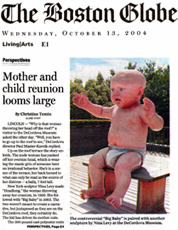|
TEMIN, CHRISTINE - BOSTON
GLOBE
PERSPECTIVES
October 13, 2004
Mother and Child Reunion Looms Large
LINCOLN -- "Why is that woman throwing her head off the roof?"
a visitor to the DeCordova Museum asked the other day. "Well, you
have to go up to the roof to see," DeCordova director Paul Master-Karnik
replied.
Up on the roof terrace the story unfolds. The nude woman has yanked off
her oversize head, which is wearing the manic grin of someone bent on
irrational behavior. She's in a corner of the terrace, her back turned
to what can only be read as the source of her distress -- a baby, 7 feet
tall.
New York sculptor Nina Levy made "Headlong," the woman
throwing away her cranium, in 1999. She followed with "Big
Baby" in 2003. The two weren't meant to create a narrative, but
juxtaposed as they are on the DeCordova roof, they certainly do. The kid
has driven its mother nuts.
The 200-pound cast polyester resin and fiberglass child was commissioned
by the Aldrich Contemporary Art Museum in the affluent community of
Ridgefield, Conn.
The museum intended the sculpture to divert attention from the
renovation and expansion that necessitated its closing last winter. A
baby would also symbolize the museum's rebirth. The last thing the
Aldrich anticipated was a controversy. The museum's public-relations
director, Amy Grabowski, remembers some affectionate gestures toward the
overgrown tot. "Somebody put a sign on him that said `Welcome Baby
Jesus,' " she says. (In the growing body of literature on the
sculpture, "Baby" is generally referred to as "he.")
One resident dressed the baby against the cold, the way tourists in
Brussels dress the "Mannequin Pis," the little bronze tyke
peeing into a fountain. But the "Mannequin Pis" is a beloved
symbol of a city. Many Ridgefielders, who are proud of their history
dating back to before the Revolutionary War, adamantly did not want
their own cute kid to become the town logo.
The headline "Baby Taints Village" screamed forth from the
Dec. 4 edition of The Ridgefield Press. Later that month, Ridgefield
resident Barbara Watson wrote to the newspaper that "Baby" was
"disgusting."
"I am surprised that no one has spray painted it yet," she
went on. Some did worse: In January, two young men set "Baby"
aflame in an attempt to incinerate him.
Fiberglass proved stronger than flesh. "Baby" convalesced in
the sculptural version of the Shriners burns hospital -- an autobody
shop. On recovery, mother and child were shipped to Lincoln for a
breather: They now overlook a majestic New England autumn, of which
they're utterly unaware. They're completely self-absorbed.
Reactions to art -- especially when it's in a public venue -- are easily
whipped into hysteria that can lead to censorship. It's nothing new. In
1573 the Inquisition objected strongly to a "Last Supper"
painted by Veronese: It featured realistic details including an apostle
wielding a toothpick to clean his teeth. Pragmatist that he was, the
artist left the painting alone, simply changing its title to "Feast
in the House of Levi," where toothpicks weren't such a big deal.
Closer to home, and closer in time, in the 1980s the artist Michael
Timpson installed a circle of pristine white toilets in the lobby of
Boston's Transportation Building on Stuart Street. The work was greeted
with comments including "What if children saw it?" (In raising
my own children, seeing a toilet sooner rather than later always seemed
a good thing.)
What the Veronese painting was to the Inquisition, what Timpson was to
the state's transportation bureaucrats, Levy's "Baby" became
to Ridgefield.
Sure, "Baby" is blond, blue-eyed, pudgy, and dimpled. Sure, he
has a more than passing likeness to the infant Christ in the great
Botticelli "Madonna of the Eucharist" in the Isabella Stewart
Gardner Museum. But while the Botticelli is bittersweet, prefiguring
Christ's fate, "Baby" is a different and altogether more
threatening creature. His eyes and mouth are wide open; his feet and
legs suggest wriggling and kicking; his arms are outstretched because he
wants to grab something or someone. He's the kid who won't sleep through
the night until he's in adolescence, the kid you have to watch every
second because otherwise he'll fall down the stairs or crawl into the
street. He's exhausting to his poor mother -- and he's too big to
ignore.
"Baby" is clothed in a diaper, modest attire not seen in
images of the baby Jesus until puritanical times dictated that either
his pose or some drapery hide his infant penis. Even the sculpture's
diaper provoked wrath. Writing about the "Baby" saga in the
Fairfield County Weekly, Brita Brundage noted that Levy modeled the
diaper on the kind of disposable ones you pick up at the supermarket.
Perhaps people in Ridgefield think that cloth diapers are superior in
some way and that God made nannies to change them and diaper services to
whisk the soiled ones away. Perhaps they consider disposables déclassé.
One upright local citizen, Hope Swenson, wrote to The Ridgefield Press
that in addition to its other offenses, the sculpture "is in dire
need of a diaper change."
Levy countered that "most disposable diapers look like that even if
they aren't full." She knew, by then, from personal experience. By
the time "Big Baby" was being fabricated, Levy had a small
baby of her own. Construction workers in her Brooklyn building, watching
her struggle with both her newborn and a 7-foot effigy of a baby,
"thought that I had some kind of post-partum derangement," she
says.
‘‘Big Baby’’ and ‘‘Headlong’’ are at the DeCordova
Museum and Sculpture Park, Lincoln, through next autumn.
© Copyright 2004 Globe Newspaper Company.
LINK
TO BOSTON GLOBE ARTICLE ONLINE REFERENCE
|
